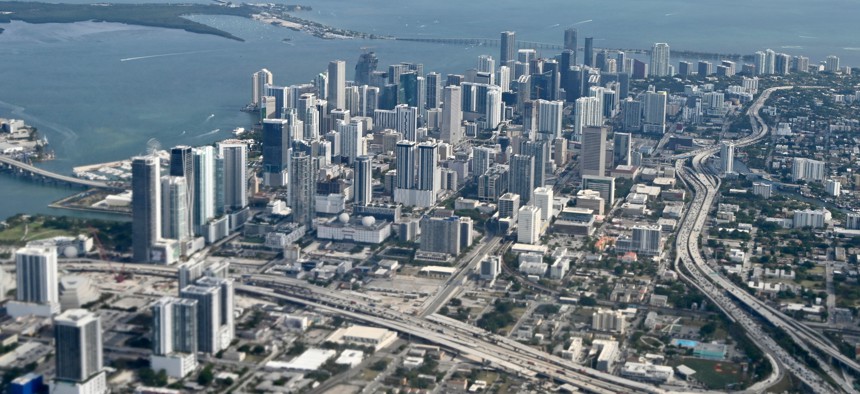Rents and Home Prices Are Blowing Up in Florida's Miami-Dade County

An aerial view shows downtown Miami, Florida, on April 27, 2022. Photo by DANIEL SLIM/AFP via Getty Images
Mayor Daniella Levine Cava has declared a rent emergency, as middle and working class families are hardest hit.
The cost of living in South Florida has Miami-Dade Mayor Daniella Levine Cava channeling perennial New York political candidate Jimmy McMillan: “The rent is too damn high.”
And in fact migrating New Yorkers are likely partly to blame, lured in part by Florida’s lack of a personal income tax – they’re fleeing the cost of living there only to drive it up as they flock to Miami and its suburbs.
Cava recently declared a rent emergency and signed into ordinance the county’s first Tenant’s Bill of Rights. Among other things, it creates an Office of Housing Advocacy. “We are facing an urgent affordability crisis,” Cava said at the Bill of Rights’ signing ceremony in May.
How bad is it? According to the RentCafé online listing service, an average Miami apartment of 887 square feet now rents for $2,132 a month. Compare that to Jacksonville, where an average apartment is 965 square feet and $1,453 a month. To be sure, there are lower priced rentals in Miami starting at $1,189 but pricier apartments cost over $3,100, with well-off newcomers competing for luxury apartments in neighborhoods with good schools.
Middle and working class families are hardest hit. Some communities in Miami-Dade are trying to help, aiming for some form of New York-style rent control. Cava has said rents have increased more than 30 percent locally over the past year.
“We have a lot of people who are working two jobs to make ends meet,” says Jon Ward, executive director of the Community Redevelopment Agency in Florida City, a Miami suburb. “We have a lot of people coming down from New York where things are incredibly more expensive. They come to South Florida and are willing to pay more for housing.
Ward told City & State Florida the problem isn’t just rent – it also extends to home buying: His neighbor just sold his house for $420,000, and he’s seeing new homes being built near him on small lots for over $700,000 each. “A lot of the people who are buying these homes pay in cash. People get into bidding wars,” he says.
In fact, two of the three top cities reporting the highest year-over-year gains in home prices are in Florida, according to the leading measure of U.S. home prices, the S&P CoreLogic Case-Shiller U.S. National Home Price NSA Index. “Tampa led the way with a 34.8% year-over-year price increase, followed by Phoenix with a 32.4% increase, and Miami with a 32.0% increase,” the index’s latest report says.
Cava spokeswoman Natalia Jaramillo said the area’s tech boom also is contributing to the affordability crisis, causing “housing price increases of 30-40%.” That’s been driven to some degree by City of Miami Mayor Francis Suarez, who has “helped catalyze a torrent of interest” as the city tries to “shave off a slice of Silicon Valley’s tech empire by establishing its own, local startup scene,” as Quartz put it in December.
Bethany Martinez, a Realtor in Miami-Dade, is becoming accustomed to the struggles that people seeking apartments and single-family homes face. She mentions another problem: Dwindling land available for new home construction. Add to that “the fact that prices are going up and many people are getting priced out. The annual pay for many people is not going up,” she says.
“We are seeing people who come to Miami and work remotely or they are buying second homes. If they are coming from outside the area and have a lot of cash, they can get a nice home,” Martinez adds. But “there is not as much inventory. We are seeing multiple offers on homes and this really drives up the price for a home.”
In April, Cava declared a housing affordability crisis in Miami-Dade County and began what’s called the Building Blocks Program to expand access to affordable housing. Goals include providing rental assistance and ensuring tenant’s rights, the first “building blocks” in dealing with the crisis. The opening of the Office of Housing Advocacy is another key, Cava has said.
Cava next plans to hold a housing summit in late June to bring together business and community leaders. She also announced additional funding for the Emergency Rental Assistance program; Miami-Dade has received an additional $13 million that will be used to support eligible residents facing major rent increases.
Ultimately, the area’s attractiveness is also a detriment. “Miami is a popular area,” Ward says, suggesting the housing affordability problem is here to stay.
David Volz has been a reporter for numerous community news publications throughout South Florida over the past two decades, as well as the South Florida Sun-Sentinel, Miami Herald and South Florida Business Journal. He covers city government, schools, sports, culture, faith groups and workplaces.
NEXT STORY: Automated Buses Will Still Need Skilled Human Operators





